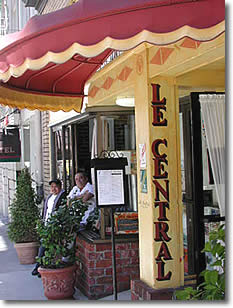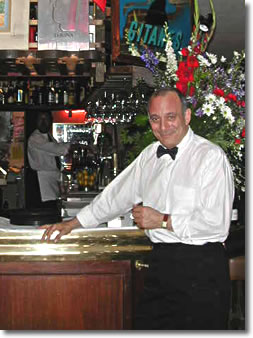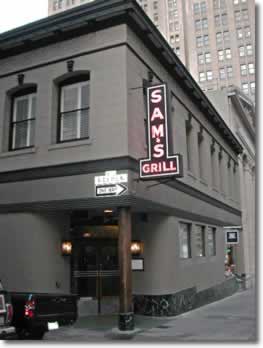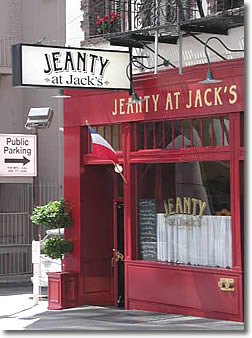|
Belden Place—A French & European Scene with Fine Dining in an AlleyBy Nina Wu with contributions from Elan Schmitt and Karen Solomon |
||
If San Francisco had a French
quarter, Belden Place would be it. Ditto a "European Quarter." The site
of the annual Bastille Day celebration (July 14th) for all the Francophiles
in In the
San Francisco tradition of mixing cultures, the chef of Cafe
Bastille (22 Belden Place), a popular casual and elegant French
eatery, is a native of Mexico. |
||
Nearby Plouf (40 Belden) is another
specialty French bistro, this time centering its |
||
| Just next door, B44 (44 Belden) fits in with the neighborhood in appearance, yet makes itself distinct with the cuisine of Catalan. Nearly every table totes a luscious pan of paella, a house specialty, or some other Spanish delight. Or would you rather have Italian? Then Cafe Tiramisu (28 Belden) is your dining destination, with an excellent selection of housemade pastas and succulent meats and fish prepared with roasted peppers, olives, capers, walnuts, and other sumptuous Italian staples. | ||
But French cuisine is really what the area is known
for, and French cuisine we shall seek. |
||
Le Central Bistro (453 Bush), just
a bit farther away from Belden along Bush Street, was formerly owned
by French brothers Claude and Pierre Cappella. It was
eventually handed over to their chef Paul Tanphanich, who runs the place
with his brother, Johnny. Le Central is a great lunch spot, with open
windows that look out onto a bustling street scene. Ex-Mayor Willie Brown
frequents the place at least three
times a week, taking the window seat that is memorialized to former San
Francisco Chronicle and was
eventually handed over to their chef Paul Tanphanich, who runs the place
with his brother, Johnny. Le Central is a great lunch spot, with open
windows that look out onto a bustling street scene. Ex-Mayor Willie Brown
frequents the place at least three
times a week, taking the window seat that is memorialized to former San
Francisco Chronicle and Examiner columnist Herb Caen. Wilkes Bashford
also goes to Le Central up to five times a week, donning one of his impeccable
suits, of course. Actor-waiter Louis Parnell, who’s worked
at Le Central more than 28 years, says Le Central is “the original
French place,” and
that it was there long before all the others arrived around the neighborhood.
The top three most popular dishes, according to Louis, are the roast
chicken, seared until crispy and flavorful with garlic and herbs, steak
pommes frites, and poached salmon. Examiner columnist Herb Caen. Wilkes Bashford
also goes to Le Central up to five times a week, donning one of his impeccable
suits, of course. Actor-waiter Louis Parnell, who’s worked
at Le Central more than 28 years, says Le Central is “the original
French place,” and
that it was there long before all the others arrived around the neighborhood.
The top three most popular dishes, according to Louis, are the roast
chicken, seared until crispy and flavorful with garlic and herbs, steak
pommes frites, and poached salmon. |
||
A bit further down Bush and yet still drenched in
that Belden Place charm is Sam’s Grill (374 Bush).
Only Tadich Grill downtown is older; this place dates back to 1867.
Here, too, the clout and visage of Herb Caen remains: A large, black-and-white
portrait graces the entryway. The history of Sam’s is a good one.
Irish immigrant Michael Bolan Moraghan started an oyster saloon called
M.B. Moraghan and Sons. The place was a hit, and it garnered a reputation
as the leading seafood establishment in town, earning Morghan the title
of “The Oyster King.” Then, Yugoslavian newcomer Samuel Zenovich
bought the emporium in 1922. After a few different names and location
changes, it would be years before people started calling the place “Sam’s”.
Today, Sam’s Grill is run by the Seput family, with two generations
involved in the family business. Sam’s offers calamari, classic
local sand dabs, sole, salmon, and other ocean delicacies from the West
and East coast. You can order separate plates of beautifully cooked vegetables
and six different type of potatoes. Meats run the range from Salisbury
steak at with mushroom sauce at $13.50 to Filet Mignon at $27.00. The
service is Old San Francisco and can't be beat. 1867.
Here, too, the clout and visage of Herb Caen remains: A large, black-and-white
portrait graces the entryway. The history of Sam’s is a good one.
Irish immigrant Michael Bolan Moraghan started an oyster saloon called
M.B. Moraghan and Sons. The place was a hit, and it garnered a reputation
as the leading seafood establishment in town, earning Morghan the title
of “The Oyster King.” Then, Yugoslavian newcomer Samuel Zenovich
bought the emporium in 1922. After a few different names and location
changes, it would be years before people started calling the place “Sam’s”.
Today, Sam’s Grill is run by the Seput family, with two generations
involved in the family business. Sam’s offers calamari, classic
local sand dabs, sole, salmon, and other ocean delicacies from the West
and East coast. You can order separate plates of beautifully cooked vegetables
and six different type of potatoes. Meats run the range from Salisbury
steak at with mushroom sauce at $13.50 to Filet Mignon at $27.00. The
service is Old San Francisco and can't be beat. |
||
Stroll two blocks west from Belden Place along Bush Street towards Grant, and you will find Cafe de la Presse (469 Bush) across from the gates of Chinatown. Aqua bought
this prime location on Grant and Bush some six months ago and in late
Spring shut it down for remodeling. While they missed their target date
for Now the extra month may be explained by the piles of
olives, pates, frites, spreads, dips, cheese platters, plates of this,
trays of that, bottles of wine, champagne,
varieties pastis—yes
almond, mint, cranberry, and more—that helped celebrate
this event. And all the big brass from Aqua was there: Laurent Monrique
(photo, right), the executive chef, Jean Claude Persais, vice president
of So the question on everyone's mind is probably this:
How is the new place, how does it compare to the old? I'm sure there
will be lots of opinions on this, but here's mine: Aqua has put a lot
of work into this place to make it topnotch. They have also retained
all the motifs of the old place: Outside tables for casual food and drink
on the corner. The newspaper rack has moved to the other wall but is
new: big beautiful stained-wood rack. Hard to complain about that. Classy
French bistro bar now in the middle where the grungy old counter used
to be. And more tables around the window side where newspaper rack used
to be. Means more window space, which is a good idea. Now the restaurant:
Again nice stained woodwork but a little noisy due to hard walls and
a high ceiling. Maybe they will find a Now ponder this one: The price is not cheap. But remember the old place? Remember the three-dollar latte that you drank out front? Remember how long it took to get and how slow the waiter was bringing the bill? Compare the new place to this and I think you have to feel like a happy customer. Cafe de la Press is now more than a "location". Compare it also to Cafe Espresso on Mason and Sutter, also a prime corner location with a similar bistro look. I like that place for reasons unknown, but others find it a tourist trap that does not deliver. I understand how they feel. Anyway, you gotta give these guys credit for a truly grand opening. Salut, Cafe de la Press! |
||
| Note:
The description below matches Jack's before it closed in 2009. Chef Phillipe
Jeanty of Napa fame is still the owner but he is being picky about who the
new owner should be. He wants it to remain Jack's and not the sales office
for a social-media startup. It is, after all, a San Francisco landmark
building (#146) and the second oldest restaurant in the City. Let us wish
him luck. It is a gem of a building and steeped in restaurant history and
lore. - Louis Martin We’ve strayed a bit far away from Belden Alley, but that does not mean that the spirit of the French cafe and bistro has left the building. Centered between  Chinatown
and the Financial District is a French bistro you won’t want to
miss: Jeanty
at Jack’s (615 Sacramento).
Founded as Jack’s
in 1864, the site is a San Francisco registered landmark. Jack’s
has had a number of owners, but the place is now under the charge of
famed Napa chef and owner Philippe Jeanty (also the owner of Bistro Jeanty
and Pere Jeanty in Yountville), and he has once again restored its life
and effervescence. The menu offers classics like coq au vin, tender steak
with bearnaise, and their famous tomato soup in puff pastry. The three-story
restaurant offers a charming homelike feel, with an iron banister festooned
with flowers, fun color sketches, wooden coat hangers, and historical
photographs—including one of Ernest Hemingway and Ingrid Bergman
in front of the restaurant. The top floor holds a private dining room,
which once was a brothel and served as a rendezvous for secret dalliances.
The new skylight floods the area with natural light, while still making
it feel very private. Chinatown
and the Financial District is a French bistro you won’t want to
miss: Jeanty
at Jack’s (615 Sacramento).
Founded as Jack’s
in 1864, the site is a San Francisco registered landmark. Jack’s
has had a number of owners, but the place is now under the charge of
famed Napa chef and owner Philippe Jeanty (also the owner of Bistro Jeanty
and Pere Jeanty in Yountville), and he has once again restored its life
and effervescence. The menu offers classics like coq au vin, tender steak
with bearnaise, and their famous tomato soup in puff pastry. The three-story
restaurant offers a charming homelike feel, with an iron banister festooned
with flowers, fun color sketches, wooden coat hangers, and historical
photographs—including one of Ernest Hemingway and Ingrid Bergman
in front of the restaurant. The top floor holds a private dining room,
which once was a brothel and served as a rendezvous for secret dalliances.
The new skylight floods the area with natural light, while still making
it feel very private. |
||
And speaking of privacy, Fleur
de Lys (777 Sutter),
named after the symbol of the French monarchy, is sequestered away like
a royal hidden treasure. Diners |
Sidewalk Cafe: La Vie Nocturne
Sidewalk Cafe: Hanging Out In Paris
The Time of Your Life in San Francisco
Paris: Almost Like Being In Love
Paris, Puigcerda Y La Comida Fantastica